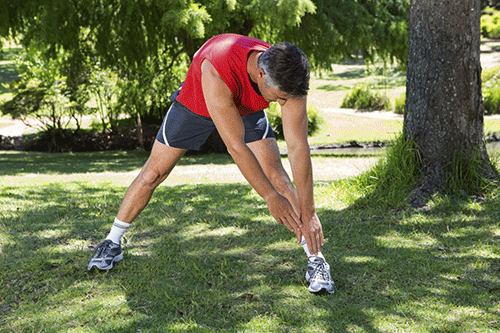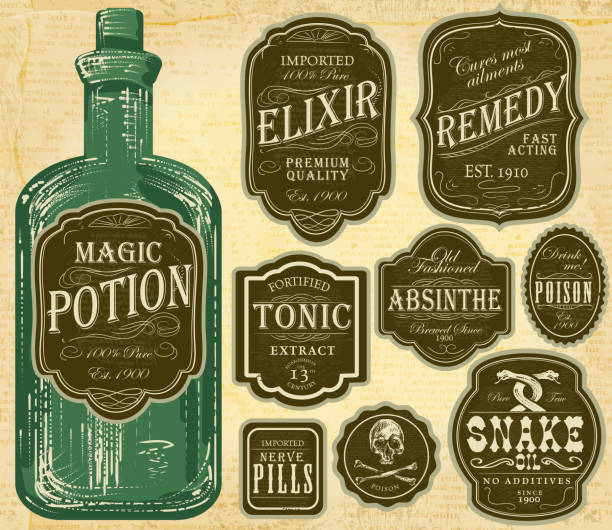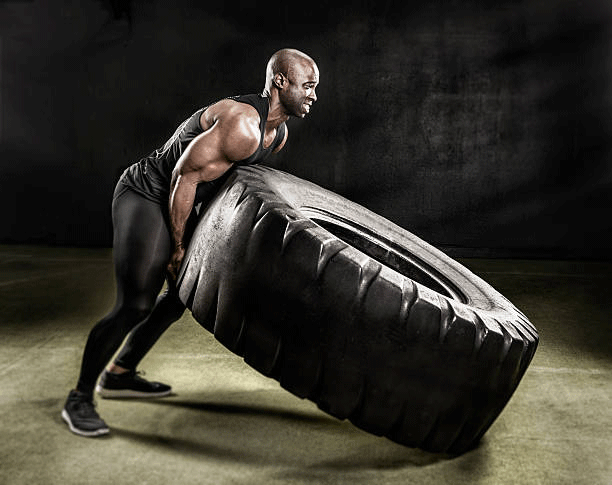 |
November 28, 2024, 3:44 am |
 |
|
 |
|
 |
Advertisments
 |
 |
|

Eve Lees
November 05, 2024
Warm up before your sport or activity
Warming up before your workout or activity helps prepare you physically and mentally for physical exertion.
Warming up raises body temperature and heart rate. This enables more oxygen-rich blood to circulate throughout your body, preparing the muscles and “greasing” the joints to move them through a full range of motion.
A three to five-minute warm-up is sufficient for workouts or physical activities lasting less than an hour. You can do this by brisk walking, doing a light jog, or using the “cardio” equipment in the gym (the exercise bike or treadmill).
For your weight-training workouts, have a short 3–5-minute warm-up on the cardio equipment. With each exercise, do the first set using little or no resistance, such as using only the bar (without adding weights) when doing the bench press. Or you can add dynamic movements such as arm circles before you do the bench press. Static movements or stretches (where you hold the stretch for 20 to 30 seconds, and no “bouncing”) are best left after the workout. Static stretching is best used to improve or maintain joint flexibility, and to signal your muscles to relax, especially after a hard workout!
To warm up before a sport, mimic the movement of your sport without using resistance to prepare your body. For instance, do torso rotations and arm swings before tennis, golf, or softball. Before playing basketball or tennis, shuffle quickly from side to side, or do lunges or high knee marches to prepare your body for jumping and quick direction changes.
The same methods for warming up should be applied to cardiovascular exercises and activities. For example, on a long bike ride, swimming laps, or going for a run, start slow and gradually ease into the activity.
Cyclists, runners, hikers, and swimmers can warm up with torso rotations, lunges, high knee marches, or brisk walking. Swimmers can add shoulder or arm rotations.
When your activity or workout ends, do static stretches to coax your body to relax. Do one or two stretches for each muscle your activity stressed: Slowly ease into the stretch and hold without “bouncing” for about 20 to 30 seconds. Relax, then repeat once more before moving on to the next stretch.
Eve Lees has been active in the health & fitness industry since 1979. Currently, she is a Freelance Health Writer for several publications and speaks to business and private groups on various health topics. www.artnews-healthnews.com
Octobere 02, 2024
Health
Eve Lees
Warm up before your sport or activity

Warming up before your workout or activity helps prepare you physically and mentally for physical exertion.
Warming up raises body temperature and heart rate. This enables more oxygen-rich blood to circulate throughout your body, preparing the muscles and “greasing” the joints to move them through a full range of motion.
A three to five-minute warm-up is sufficient for workouts or physical activities lasting less than an hour. You can do this by brisk walking, doing a light jog, or using the “cardio” equipment in the gym (the exercise bike or treadmill).
For your weight-training workouts, have a short 3–5-minute warm-up on the cardio equipment. With each exercise, do the first set using little or no resistance, such as using only the bar (without adding weights) when doing the bench press. Or you can add dynamic movements such as arm circles before you do the bench press. Static movements or stretches (where you hold the stretch for 20 to 30 seconds) are best left after the workout. Static stretching is best used to improve or maintain joint flexibility, and to signal your muscles to relax, especially after a hard workout!
To warm up before a sport, mimic the movement of your sport without using resistance to prepare your body. For instance, do torso rotations and arm swings before tennis, golf, or softball. Before playing basketball or tennis, shuffle quickly from side to side, or do lunges or high knee marches to prepare your body for jumping and quick direction changes.
The same methods for warming up should be applied to cardiovascular exercises and activities. For example, on a long bike ride, swimming laps, or going for a run, start slow and gradually ease into the activity.
Cyclists, runners, hikers, and swimmers can warm up with torso rotations, lunges, high knee marches, or brisk walking. Swimmers can add shoulder or arm rotations.
When your activity or workout ends, do static stretches to coax your body to relax. Do one or two stretches for each muscle your activity stressed: Slowly ease into the stretch and hold without bouncing for about 20 to 30 seconds. Relax, then repeat once more before moving on to the next stretch.
Eve Lees has been active in the health & fitness industry since 1979. Currently, she is a Freelance Health Writer for several publications and speaks to business and private groups on various health topics. www.artnews-healthnews.com
September 15, 2024
Food facts . . .
Chestnuts are truly nuts, despite their soft texture. And they are the only nuts that are low in fat. Half a cup provides only 1.6 grams of fat, compared to about 32 grams found in most nuts.
Two small kiwi fruits provide more potassium than a banana, just as much fiber as a grapefruit, and twice the vitamin C of an orange.
White asparagus is not genetically modified. The white colour is natural.
Beets and sweet potatoes can be eaten raw as well as cooked. Shred them raw into your salads. Asparagus and okra can be eaten raw too.
Making a salad? Add tasty rose petals from your garden (if they are pesticide-free!). You’ll beautify your salad as well as add a little vitamin C.
Legumes (chickpeas, beans, lentils, etc.) are among the richest sources of fibre in our diet.
Cooking chicken with the skin on won’t increase the fat content of the meat. But it will effectively help moisten the meat, especially those dryer chicken breasts! If you choose to eat low-fat, simply remove the skin before eating.
Pears are a great source of fiber; one medium pear provides six grams.
Red rooibos tea contains quercetin, an anti-inflammatory that can help lower blood pressure.
Don’t ignore frozen foods. They can still offer vital nutrients like vitamin C, lutein, and beta-carotene as when they are fresh.
Tests show that steaming or microwaving foods – rather than boiling them – will minimize the loss of water-soluble vitamins.
Caution: One cup of bubble tea can contain as much as 54 grams of sugar.
Eve Lees is a health writer and speaker. She was a Personal Trainer and Nutrition Counsellor for over 30 years. www.artnews-healthnews.com
August 07, 2024
Food that fight inflammation
Inflammation in our bodies can become chronic due to diseases, disorders, and of course, injuries. Research continues to show we can control and minimize inflammation in the body with diet. And it’s also disturbing to realize our diet can also be a cause of inflammation.
The foods we eat can influence the type of bacteria and their chemical byproducts, that populate our “gut.” Some foods can encourage the growth of the types of bacteria that stimulate inflammation while others encourage the type of bacteria that help suppress inflammation. Therefore, it’s wise to focus primarily on those foods that lower the inflammatory response, especially if we are already suffering from a disease or disorder or are healing from an injury.
Foods credited as fighting or lowering inflammation:
Fruits and vegetables – particularly those brighter and deeper in colour – offer high amounts of antioxidants (‘disease-fighters’) and polyphenols (protective compounds in plants). However, even those foods lighter in colour (like cauliflower) offer varying amounts and different types of antioxidants and polyphenols. Simply focus on eating more of any fruit or vegetable.
Nuts and seeds have been found to reduce the markers of inflammation with their various disease-fighting properties and have been linked to lowering the risk of diabetes and cardiovascular disease. But don’t go overboard! Weight gain increases the risk of inflammation. A daily handful (in total) of a variety of nuts and seeds is all you need.
Oils and fatty fish that are richer in omega-3 fatty acids have also been shown to reduce inflammation. Choose oils like olive or flaxseed, and the fattier fish, like salmon, sardines and mackerel. That doesn’t mean avoiding other healthy oils or even white, lower-in-fat- fish, as they all offer other health-benefiting properties. It simply means to be sure to choose the omega-3-rich choices more often.
Cocoa, green tea and many herbal teas also offer anti-inflammatory properties. Coffee also offers properties that can reduce the inflammatory response, but use caution. We are all “wired” differently and can react differently to foods: Other properties of coffee may have negative effects on your health, like its caffeine, its sulphur content, or its high acidity. Therefore, if you stop drinking coffee because it just doesn’t agree with you, don’t start because research says it can reduce inflammation. Opt for herbal teas, instead!
Foods noted to cause or exacerbate inflammation:
Foods contributing to inflammation are also usually considered bad for overall health: Sugar-rich sodas, highly refined carbohydrates (cookies, cakes, etc.), processed meats, and highly processed foods (identified by containing one or more ingredients that you would not find in your kitchen). Some additives added to highly processed foods are linked to negative changes in gut bacteria (which can create inflammation). Many of these additives were created to mimic “real foods” as cheaper replacements (things like high fructose corn syrup or emulsifiers added to foods such as ice cream, to ensure a creamier texture).
Allergies or sensitivities to certain foods may also contribute to inflammation. It may be wise to avoid or severely limit your intake. However, be sure you are indeed reacting to these foods. While allergy tests aren’t 100 percent accurate, they can be used in conjunction with food elimination tests to determine if you are truly reacting to a particular food. Omitting a healthy food from your diet because you think it’s affecting you is not a good idea. There may be essential nutrients in the food that you need. Talk with your doctor and visit a knowledgeable specialist concerning food allergies and sensitivities.
To ensure you are following an anti-inflammatory diet, place more of a focus on fruits, vegetables, nuts, whole grains, fish, and healthy oils. These foods should be changed as little as possible (washing, cutting and cooking – but not overcooking – is the only ‘processing’ that should be done to your food!). Limit or avoid packaged and prepared foods and drinks as these are usually rich in simple sugars, salt, or other unrecognizable “additives” we really don’t need in our diets.
Eve Lees is a health writer and speaker. She was a Personal Trainer and Nutrition Counsellor for over 30 years. www.artnews-healthnews.com
July 04, 2024
Get your chemical fix outdoors

Exercising outdoors has many benefits and maintains an appreciation and respect for nature. And research continues to uncover why we should stay connected with "nature."
You have the benefits of fresh air (depending on where you live), the vitamin D from sunlight, and, surprisingly, the chemicals we are exposed to.
Chemicals? Yes, plants and animals like us humans all benefit from airborne chemicals. Being outdoors and exposed to plants can lower the stress hormone cortisone levels, lower resting heart rate, and decrease blood pressure. That's partly due to the immune system boost that plants and trees can offer us. Scientists suggest that humans may also benefit from airborne chemicals called phytoncides, which protect plants from fungi, bacteria, and insects. Researchers found those taking long walks in a forest had a 50% increase in natural killer cells – these cells circulate through the body to kill bacteria, viruses, fungi, and other invaders.
Forest bathing is becoming popular because of this 'chemical' research. Japanese researchers found walking in wooded areas decreased physiological measures such as heart rate and blood pressure. This was recognized after measuring and comparing the brain activity and vital signs of 12 male college students during a walk in a forest versus a walk in an urban setting. Walking in the forest reduced the oxyhemoglobin concentrations in the brain's prefrontal cortex, which indicates the sympathetic nervous system is relaxed. At the end of the forest walk, blood pressure dropped 6 points but rose 6 points during the city walk.
So, how much green time do you need? Not much, say researchers. Ideally, spend as much time as you can outside. But your mental health will benefit with as little as five minutes of exercising in a park, working in a garden, hiking a nature trail, or just sitting among plants. Researchers analyzed 1,252 people of different ages, genders, and mental health states in one study as they walked, gardened, cycled, fished, boated, rode horses, and farmed. More significant health changes occurred in the young and the mentally ill. However, people of all ages and social groups benefited. Any natural environment is ideal, including parks or green areas within cities, but green areas beside water were especially beneficial.
It's not just greenery that promises health benefits. Consider yourself fortunate if you live by a large body of water. Sea air can be energizing and help you sleep better.
Sea air is rich in charged negative hydrogen ions, which can neutralize damaging positive ions known as free radicals. As a result, this improves our ability to absorb oxygen, helping us to feel more relaxed and energetic throughout the day. And this can result in sleeping more soundly at night. In any case, sea air or forest air, spending time outdoors allows your body to receive more oxygen, which improves your ability to get a good night's sleep.
Any outdoor enthusiast will tell you what science is beginning to discover: Being outside feels good!
Eve Lees has been active in the health & fitness industry since 1979. She is a Freelance Health Writer for several publications and speaks to business and private groups on various health topics. www.artnews-healthnews.com
-30-
June 18, 2024
It's normal to forget

Being a little forgetful is expected as we age. By the time we hit mid-30s, our memories begin to fade and continue to do so as the years pass. This is normal. The human brain works slower in old age because more information is stored over time.
A recent study revealed that when a computer is downloaded with the words and learning a person might encounter in a lifetime, its performance slows, similar to an adult's performance on cognitive tests. The program slowed because the database grew, taking longer to search the database, not because its ability to process had declined. When a computer was programmed to simulate the performance of young adults, the results were faster because of the smaller database.
Experts say as we grow older, we can expect the following memory lapses;
-
Forgetting names of those we see infrequently or the name of someone we are familiar with if we see them in unfamiliar surroundings.
-
Forgetting details of a recent conversation.
-
Repeating a story to the same person more than once in a week.
-
Phone numbers, passwords, postal codes, etc., are not as easy to memorize.
-
Forgetting one item (among several) on a trip to the store.
-
Entering a room and forgetting why or what you were looking for.
As we age, many of us become busier and have more to remember. Getting organized can help. Helpful memory aids include:
-
Make notes. Keep a list of daily tasks that need to be done. Jot down reminders in a journal or an appointment book.
-
Don't procrastinate. Do things as soon as possible so they are not forgotten.
-
Pay attention when others speak. Listen carefully to remember their name or details of a story.
-
Repeat what you want to remember several times, and you'll likely remember it.
-
Set an alert on your cell phone or set your egg timer if you're afraid of forgetting to attend a meeting or pick up the granddaughter from dance class.
Severe memory problems, however, can be a warning of more serious illnesses such as Alzheimer's. Be concerned if you forget the names of close family members, forget more than one conversation daily, repeat a story to the same person within a few hours, or completely forget something you've just done, such as a trip to the grocery store.
Experts are still learning how to keep our minds sharp as we age. What is known so far is that a healthy diet, adequate sleep, stress management, and regular moderate activity are linked to brain health. Research also shows that activities involving coordinating the mind and physical movement together seem more effective than doing a physical activity separate from a mental activity alone. A combination may be essential to a more effective stimulation of the brain.
Try activities where you must "think" about how you need to move your body, like brushing your teeth with your less dominant hand (use your left hand instead of your right if you are right-handed), walk backwards up the stairs (but go slow and hold the handrail, please!), and other movements that are unfamiliar to you and you need to think as you do them. Learning to play a musical instrument is also an effective exercise for the brain. For example, learning to play the guitar requires your mind to coordinate both hands moving differently (one strumming, the other chording). And if you add singing along, you have plenty of physical activities for your brain to coordinate!
Yoga, Tai Chi, Pilates, Qigong, martial arts, and many other types of dance are also excellent choices for mind-body exercises. Sports that require concentration or strategy may also be more effective in "working" your brain than just sitting and playing chess: for example, concentrate (more than you usually do!) on where you want to place your golf ball and how you must move to do that. Or the action you need to take to send your bowling ball or curling rock exactly where you want it to go. Tennis or badminton are other "strategy games" – as long as you are actively using your mind to concentrate on how you need to move your body to achieve a goal.
Another idea is to set up an "obstacle course" in your living room. You can do this as a workout or add to it: Step over pillows set on the floor, step sideways around footstools or chairs, and walk backwards around the dining room table. Set a ladder on the ground outside and step between the rungs (go slow if you've never done this before!). All these suggestions keep your mind focused on moving your body in ways other than just moving it straight ahead. Even small efforts like concentrating on feeling your muscles while lifting weights can stimulate those brain neurons.
Eat healthfully, relax and sleep well, and concentrate on your movements – these are all helpful ways that may improve your brain health. Don't forget to think about it.
Eve Lees is a health writer and speaker. She was a Personal Trainer and Nutrition Counsellor for 30 years. www.artnews-healthnews.com
-30-
WORDS: 812
SOURCES:
Alzheimer Society of BC and the Alzheimer's web site.
Topics in Cognitive Science, 6(1):5-42
April 30, 2024
Health History – quirky treatments of the past!

If you’re wary about today’s medical treatments, be happy you didn’t live over one hundred years ago . . .
In 1899, asthma patients were recommended to try smoking to relieve their disorder.
In 650 BC, headaches, neck pain, intestinal ailments, and impotence were signs of omens. Remedies were created to identify the demons responsible, and they were expelled with spells or incantations. Dog dung was used in many treatments to help drive off demons.
Throughout the 1800’s and until the early 1900’s, it was common practice to use laudanum (opium) to raise the spirits or relieve minor pain. Dr. J. Collis Browne’s Chlorodyne was taken like morning tea, and Queen Victoria served her guests Vin Mariani, a popular solution of cocaine.
Until at least the 17th century, religion and magic were primary medical therapies. Bread baked on Good Friday would never go mouldy and would treat all types of diseases. Rings made from silver collected at the Eucharist would cure convulsions. The sacrament of confirmation would keep sickness away.
In the late 1800s, home remedies were available in stores, catalogues, and by direct mail from manufacturers. Each brand claimed to provide the vital key to health. Here are some examples . . .
Liquor was the main ingredient of most patent medicines. In addition to vegetable extracts and sugar, which gave each brand its own unique flavour and colour, remedies were also laced with cocaine, caffeine, opium, or morphine.
The Sears catalogue, for example, sold a morphine-laced mixture intended to be slipped into a wayward husband’s coffee to keep him home nights. Unfortunately, it ended up being the bored homemakers and older people who imbibed in the concoction, developing an addiction.
The 1899 edition of the medical textbook the Merck Manual, was another source of treatment for several disorders. Uncontrollable sexual urges in a man were treated with a potent sedative heavily laced with alcohol. Females were given a different prescription: sulphuric acid, camphor, or tobacco. Typhoid fever was treated with morphine, opium, and cold baths. Puerperal fever, a strep infection that killed women after giving birth, was treated with bloodletting and chloroform. For meningitis, a brain infection still fatal today, the 1899 treatment was iodine and turpentine massaged into the skin. For baldness, a standard medical treatment was to apply ammonia to the bare skin or to take a “little” arsenic.
However, some individuals were years ahead of their time in their sensible approach to treating poor health. The eminent Canadian physician William Osler (1849-1919) advocated, “The physician treats the disease, but the great physician treats the patient.” He also believed, “It is much more important to know what sort of patient has the disease, than to know what sort of disease the patient has.”
Eve Lees has been active in the health & fitness industry since 1979. Currently, she is a Freelance Health Writer for several publications and speaks to business and private groups on various health topics.
https://www.artnews-healthnews.com/health-writing
March 12, 2024
Shock your body to improve your fitness

Making your workout harder is just one way to advance in your fitness program. But how hard you push yourself isn’t the only consideration and not really a necessary one if you aren’t training to compete. Simply changing your program around will shock your body enough to continue stimulating the changes needed to raise your fitness level.
Muscles adapt to patterns of stress. So, it’s a good idea to mix things up to continue seeing results. Every three or four months is a good rule of thumb to make a small change in your regular routine. Here are a few suggestions to alter your current exercise program without necessarily upping the intensity of effort.
If you ride a stationary exercise bike, occasionally stand up while pedalling (increase the tension while you do this), pedal backwards, or sit on the floor (or a chair) behind the bike while you pedal (you might have to secure the bike somehow, so you won’t slide it forward as you pedal). This position is like riding a reclining cycle and puts more stress on your hamstrings. NOTE: Adjusting your leg reach when sitting on the floor behind your bike is the same as leg reach when sitting upright on the bike seat: Your fully straightened leg should be slightly bent at the knee.
Change the order of your weight training exercises or replace your usual exercises with entirely new ones for each muscle group. If you usually do three or four sets of each exercise, do just one set for each exercise, then repeat the series again three or four times.
If you like to run, consider water running in waist-deep water or experiment with Nordic Walking (fitness walking with poles) to involve an upper body workout at the same time.
Walkers can occasionally break into a short sprint. For example, walk briskly for one minute, then sprint or skip for 30 seconds. Repeat as often as you like. Or you can try shuffling sideways or backwards for short intervals (watch out for garbage cans and other obstacles!).
Take a week or two away from your usual exercise activity every three or four months. Try something completely different, like Pilates, yoga, martial arts or even a leisure activity like golf. Two weeks isn’t long enough to backslide (lose your fitness level) in your usual fitness routine. But it offers enough of a break so that when you return to the activity, you’ll continue to advance and see improvement. This is a great way to avoid plateaus.
If your cardio routine involves doing only one activity, consider breaking it up by doing several different activities. For example, if you usually run on the treadmill for 30 minutes, try doing ten minutes of three other activities, such as stationary cycling, stepping, and rope jumping. Or include walking briskly up and down your staircase if you live in a two-story home. You’ll still get the heart/lung and fat-burning benefits of a longer, single activity. In addition, you’ll work different muscles and alleviate boredom. Your workout may even seem shorter when you spend less time on each activity.
Eve Lees has been active in the health & fitness industry since 1979. Currently, she is a Freelance Health Writer for several publications and speaks to business and private groups on various health topics https://www.artnews-healthnews.com/health-writing
|
|
|
















